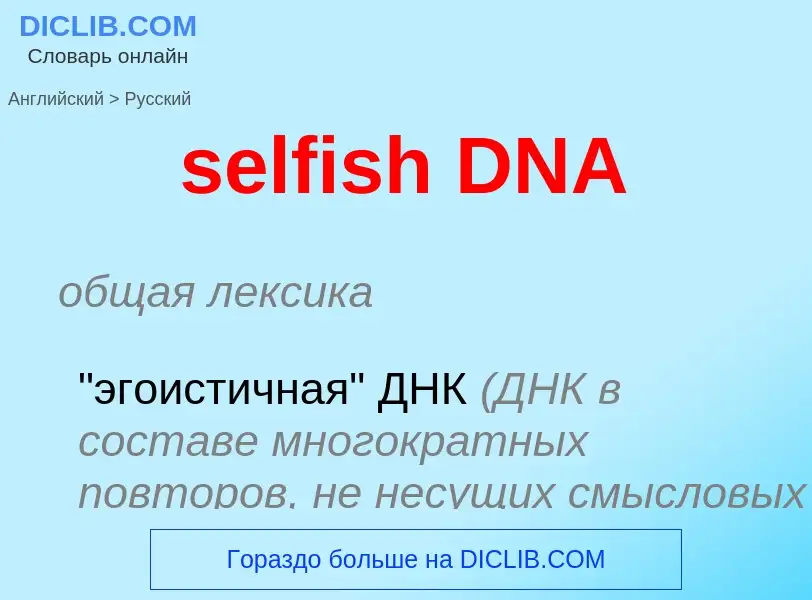Vertaling en analyse van woorden door kunstmatige intelligentie ChatGPT
Op deze pagina kunt u een gedetailleerde analyse krijgen van een woord of zin, geproduceerd met behulp van de beste kunstmatige intelligentietechnologie tot nu toe:
- hoe het woord wordt gebruikt
- gebruiksfrequentie
- het wordt vaker gebruikt in mondelinge of schriftelijke toespraken
- opties voor woordvertaling
- Gebruiksvoorbeelden (meerdere zinnen met vertaling)
- etymologie
selfish DNA - vertaling naar russisch
общая лексика
"эгоистичная" ДНК (ДНК в составе многократных повторов, не несущих смысловых функций)
общая лексика
ДНК
дезоксирибонуклеиновая кислота
(Distributed Internet Application) распределённые приложения Интернет, архитектура DNA
(Digital Network Architecture) архитектура цифровой сети
сетевая архитектура, разработанная корпорацией Digital Equipment. Реализована в сети DECnet
синоним
Смотрите также
существительное
общая лексика
архитектура цифровых сетей
синоним
['s(j)u:pəkɔil]
общая лексика
суперспираль
спираль второго порядка
синоним
Wikipedia
Selfish genetic elements (historically also referred to as selfish genes, ultra-selfish genes, selfish DNA, parasitic DNA and genomic outlaws) are genetic segments that can enhance their own transmission at the expense of other genes in the genome, even if this has no positive or a net negative effect on organismal fitness. Genomes have traditionally been viewed as cohesive units, with genes acting together to improve the fitness of the organism. However, when genes have some control over their own transmission, the rules can change, and so just like all social groups, genomes are vulnerable to selfish behaviour by their parts.
Early observations of selfish genetic elements were made almost a century ago, but the topic did not get widespread attention until several decades later. Inspired by the gene-centred views of evolution popularized by George Williams and Richard Dawkins, two papers were published back-to-back in Nature in 1980 – by Leslie Orgel and Francis Crick and by Ford Doolittle and Carmen Sapienza – introducing the concept of selfish genetic elements (at the time called "selfish DNA") to the wider scientific community. Both papers emphasized that genes can spread in a population regardless of their effect on organismal fitness as long as they have a transmission advantage.
Selfish genetic elements have now been described in most groups of organisms, and they demonstrate a remarkable diversity in the ways by which they promote their own transmission. Though long dismissed as genetic curiosities, with little relevance for evolution, they are now recognized to affect a wide swath of biological processes, ranging from genome size and architecture to speciation.

![Selfish mitochondria]]). While mitochondrial and chloroplast genes are generally maternally inherited, B chromosomes can be preferentially transmitted through both males and females. Selfish mitochondria]]). While mitochondrial and chloroplast genes are generally maternally inherited, B chromosomes can be preferentially transmitted through both males and females.](https://commons.wikimedia.org/wiki/Special:FilePath/Cell with transmission patterns.png?width=200)




.png?width=200)


![DNA major and minor grooves. The latter is a binding site for the [[Hoechst stain]] dye 33258. DNA major and minor grooves. The latter is a binding site for the [[Hoechst stain]] dye 33258.](https://commons.wikimedia.org/wiki/Special:FilePath/DNA-ligand-by-Abalone.png?width=200)
![animated version]]). animated version]]).](https://commons.wikimedia.org/wiki/Special:FilePath/DNA animation.gif?width=200)

![B]] and [[Z-DNA]] B]] and [[Z-DNA]]](https://commons.wikimedia.org/wiki/Special:FilePath/Dnaconformations.png?width=200)

.jpg?width=200)




![[[Maclyn McCarty]] (left) shakes hands with [[Francis Crick]] and [[James Watson]], co-originators of the double-helix model based on the X-ray diffraction data and insights of Rosalind Franklin and Raymond Gosling. [[Maclyn McCarty]] (left) shakes hands with [[Francis Crick]] and [[James Watson]], co-originators of the double-helix model based on the X-ray diffraction data and insights of Rosalind Franklin and Raymond Gosling.](https://commons.wikimedia.org/wiki/Special:FilePath/Maclyn McCarty with Francis Crick and James D Watson - 10.1371 journal.pbio.0030341.g001-O.jpg?width=200)
![Interaction of DNA (in orange) with [[histone]]s (in blue). These proteins' basic amino acids bind to the acidic phosphate groups on DNA. Interaction of DNA (in orange) with [[histone]]s (in blue). These proteins' basic amino acids bind to the acidic phosphate groups on DNA.](https://commons.wikimedia.org/wiki/Special:FilePath/Nucleosome1.png?width=200)




![The Eagle]] [[pub]] commemorating Crick and Watson The Eagle]] [[pub]] commemorating Crick and Watson](https://commons.wikimedia.org/wiki/Special:FilePath/TheEaglePub-Cambridge-BluePlaque.jpg?width=200)





